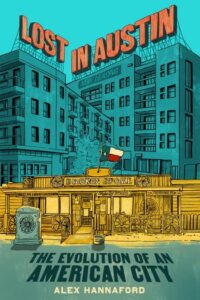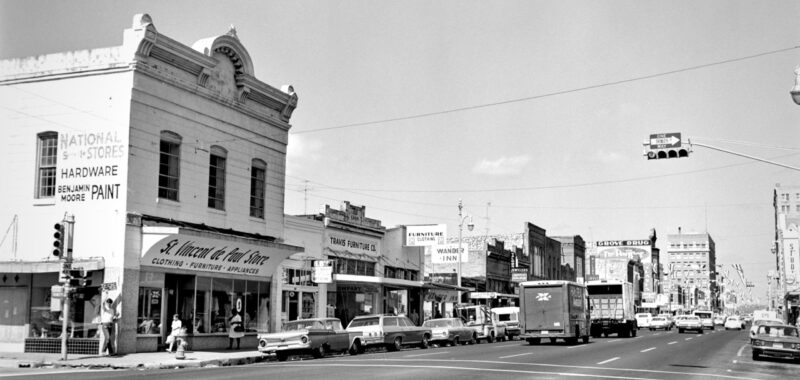I knew why we’d left Austin after calling it home for so long; how the humidity and searing heat had taken its toll after 17 years; how my wife and I were tired of worrying about keeping our daughter safe, considering the proliferation of guns in Texas; how the city had morphed into a place we no longer recognized. But now I needed to look at the effect these and other profound changes had had on other people too; to consider the ramifications of a changing Austin from other vantages.
Article continues after advertisement
Lost in Austin: The Evolution of an American City is my attempt to articulate what happened to a place that was, for the past decade, the fastest growing large metro area in the country. It’s about gentrification and climate change and guns and immigration; it’s about Elon Musk’s arrival. And Joe Rogan’s. And it’s also about how my deep love affair with a city turned sour. I also wanted it to serve as a warning for what the homogenization of cities means for the American urban identity.
Something had changed so dramatically in Austin, that dewy eyed nostalgia or biased memory couldn’t explain it away.
We moved away from Austin in the late spring of 2020—to the northeast, where we’d have seasons again. Now I was tasked with writing about a place I’d lived in for so long, but dispassionately, with a journalist’s perspective. I had skin in the game, and in almost two decades living there, Austin had gotten under my skin.
I first moved there from England in 2003. I’d first spent time in the Texas capital on a road trip across the States a few years before, and ever since, I’d conspired to make it my home. In the book, I write: “For nearly two decades, I’d had a front-row seat to the meteoric changes in one of the most rapidly expanding cities in America. The New York Times called its real estate market a “madhouse,” saying it had forced regular people to act like “speculators.” It was the only major growing city in America to have a declining Black population. What’s more, it was still trading on its credentials as the “Live Music Capital of the World”…yet working musicians couldn’t afford to park downtown to unload their gear, let alone live there.”
I was conscious of three key things when I set about researching Lost in Austin: one, I knew my experience of living in—and leaving—the city was one of privilege; hugely different from someone who didn’t have the luxury of selling a home they’d owned for a decade, packing everything into a removal van, and then relocating across the country. Two, that the cost of living in Austin—the rise in property prices, taxes, and rents—hadn’t affected me nearly as profoundly as it had other people. And three, there were inevitably people who still lived in Austin, or who had moved there recently, who thought it was fantastic.
There’s a saying that Austin was the greatest place on Earth the day you moved to town. We’re all inclined to wear rose-tinted glasses when we think of our past. But something had changed so dramatically in Austin, that dewy eyed nostalgia or biased memory couldn’t explain it away. Until recently, Austin was affordable for most people. There was a time in the not-too-distant past that you could afford to be poor there. And the excitement that that diverse group of city dwellers who were musicians and artists and cooks and teachers and actors and writers created then drew in people who essentially extinguished them from the city.
Austin’s cultural capital is the reason people who relocate there for work are so excited about the move. So what happens when they get there and realize that the cultural capital they’d been sold is now essentially pricey restaurants, sanitized streets, private members’ clubs, and high-end stores?
In 2014 I worked on a small booklet about Austin’s “working poor” with my photographer friend Matt Rainwaters. It was a project for United Way for Greater Austin, a nonprofit devoted to fighting poverty, and we called the booklet Struggle. The working poor are those who spend at least 27 weeks a year in the labor force but whose incomes still fall below the official poverty level. Women workers are more likely to be poor than men. African American and Hispanic workers are twice as likely to be poor as whites.
This influx of new people to Austin had meant a greater demand for services. More services create more jobs, but more jobs also push wages down. And with rents skyrocketing, most renters just couldn’t afford a two-bedroom apartment without a second income. These were the people I needed to speak to for a book about the impact of a changing Austin.
Journalist Erica Grieder’s book Big, Hot, Cheap and Right: What America Can Learn from the Strange Genius of Texas attributed the state’s success to being business friendly and having low taxes and light regulation. But as my friend Forrest Wilder, reviewing Grieder’s book for the Texas Observer, put it: a state in which a quarter of all people go without health insurance does not strike me as one possessing a system that “clearly and incontrovertibly worked.” A state where one in four children live in poverty is not one that’s “getting better for everyone.” A state that’s second-to-last in per-capita spending on mental health care and has one of the highest incarceration rates in the world is not one “where no one’s been disappointed.”
I didn’t want to write a book about why I left Austin. I wanted to write a book about why other people were forced to leave.
For Struggle, I interviewed Eduardo Ortiz who was 26 when he moved to Austin from Puerto Rico. Eduardo wanted to be a sound designer and while he began to build up his clientele, he survived by working two jobs waiting tables. “I’d get off at 6 a.m., go to sleep by 7 a.m., wake up at 3 p.m., then sit in front of my computer working on a project,” he told me. “Then I’d be back at the restaurant at 9 p.m. I was exhausted but I had a vision; I had a dream,” he said. “You get to the age when you don’t just want to wait tables any more. It’s a slow process.” When we met, he was making a little under $2,000 a month. With rents on the rise and the cost of living going up, Eduardo could barely afford to enjoy the fruits of his labor.
And I met Donna Langley, a retired environmental services supervisor at a local hospital. Donna was living on social security, working in the evenings as a cleaner. “It’s rough,” she told me. “And living in Austin—it’s something else. I’ve never seen anywhere so expensive.” Donna and her husband had begun growing tomatoes, cucumbers, squash, cabbage and onions, which she told me had really helped because the cost of groceries had soared.
All the people I’d met for the Struggle project just wanted a living wage and to live in a city that they loved, but which was affordable.
But as the cost of living went up, the service industry—bars, restaurants, hotels, even the retail stores—couldn’t find workers. And they couldn’t find them because the people they’d usually hire to do those jobs couldn’t afford to live in Austin. For Lost in Austin, I spoke to undocumented immigrants, cafe owners, homeowners, lifelong Austinites; everyday people who had called this place home their entire lives and had watched it transform into something they no longer recognized.
We bought our home there in 2010. It was a single story, 1,450-square-foot new build, with three bedrooms on a quarter-acre lot, just four miles from downtown. And it cost us $165,000. Austin was affordable then. I believe that four or five years later—around the time I wrote that small booklet about Austin’s working poor—came the tipping point; when Austin, Texas, became unaffordable for most people.
I didn’t want to write a book about why I left Austin. I wanted to write a book about why other people were forced to leave Austin or were considering it, and what we could have done to stop them leaving. Saying goodbye Austin was bittersweet, but for me at least, the city we left behind wasn’t the city I was so desperate to call home all those years ago.
__________________________________

Lost in Austin: The Evolution of an American City by Alex Hannaford is available from Dey Street Books, an imprint of HarperCollins Publishers.

